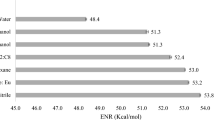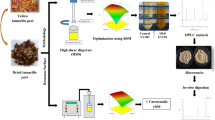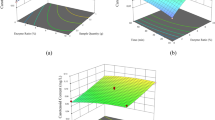Abstract
This study aimed to recover β-carotene from peels produced as a by-product during the industrial processing of pumpkins using a high-efficiency technology that produces no waste and is harmless to the environment. β-Carotene extraction from pumpkin peel was carried out by maceration and ultrasound-assisted technique, with sunflower oil instead of n-hexane as an environment-friendly solvent. Influence of the lecithin:PGPR (polyglycerol polyricinoleate) ratio was studied for microemulsion solvent method on β-carotene extraction. Response Surface Methodoloy was used to optimize the parameters of each performed treatment. The produced sunflower oil was utilized to prepare mayonnaise. Sensory flavor of the product, as well as the change in color and peroxide characteristics after rapid storage were also determined. Under optimal conditions, maceration with sunflower oil, maceration with n-hexane, ultrasound-assisted, and microemulsion solvent methods, extracted β-carotene levels were 99.83, 125.75, 127.93, and 149.71 mg/100 g DM, respectively. Most efficient β-carotene extraction was obtained utilizing a microemulsion system with 0.098% lecithin and 1.902% PGPR as the solvent. Mayonnaise made with β-carotene-rich sunflower oil was well received in terms of sensory quality, with no negative changes in the product's unique features. β-Carotene enhanced mayonnaise was more resistant to oxidation during storage than the control mayonnaise as shown by the results of color and peroxide values.
Graphical Abstract








Similar content being viewed by others
Data Availability
Enquiries about data availability should be directed to the authors.
References
Esparza, I., Jiménez-Moreno, N., Bimbela, F., Ancín-Azpilicueta, C., Gandía, L.M.: Fruit and vegetable waste management: conventional and emerging approaches. J. Environ. Manag. (2020). https://doi.org/10.1016/j.jenvman.2020.110510
Shetty, A.A., Rana, R., Buckseth, T., Preetham, S.P.: Waste utilization in cucurbits: a review. Waste Biomass Valoriz. (2012). https://doi.org/10.1007/s12649-012-9114-x
Sagar, N.A., Pareek, S., Sharma, S., Yahia, E.M., Lobo, M.G.: Fruit and vegetable waste: bioactive compounds, their extraction, and possible utilization. Comp. Rev. Food Sci. Food Saf. (2018). https://doi.org/10.1111/1541-4337.12330
Jayesree, N., Hang, P.K., Priyangaa, A., Krishnamurthy, N.P., Ramanan, R.N., Turki, M.A., Ooi, C.W.: Valorisation of carrot peel waste by water-induced hydrocolloidal complexation for extraction of carote and pectin. Chemosphere (2021). https://doi.org/10.1016/j.chemosphere.2021.129919
Duque-Acevedo, M., Belmonte-Ureña, L.J., Yakovleva, N., Camacho-Ferre, F.: Analysis of the circular economic production models and their approach in agriculture and agricultural waste biomass management. Int. J. Environ. Res. Public Health (2020). https://doi.org/10.3390/ijerph17249549
Saini, A., Panesar, P.S., Bera, M.B.: Valorization of fruits and vegetables waste through green extraction of bioactive compounds and their nanoemulsions-based delivery system. Bioresour. Bioprocess. (2019). https://doi.org/10.1186/s40643-019-0261-9
Martins, N., Ferreira, I.C.: Wastes and by-products: upcoming sources of carotenoids for biotechnological purposes and health-related applications. Trends Food Sci. Technol. 62, 33–48 (2017)
da Silva Lima, R., Nunes, I.L., Block, J.M.: Ultrasound-assisted extraction for the recovery of carotenoids from Guava’s pulp and waste powders. Plant Foods Hum. Nutr. (2020). https://doi.org/10.1007/s11130-019-00784-0
Stoica, A., Dobre, T., Stroescu, M., Sturzoiu, A., Pârvulescu, O.C.: From laboratory to scale-up by modelling in two cases of β-carotene extraction from vegetable products. Food Bioprod. Process. (2015). https://doi.org/10.1016/j.fbp.2014.02.005
Gul, K., Tak, A., Singh, A.K., Singh, P., Yousuf, B., Wani, A.A.: Chemistry, encapsulation, and health benefits of β-carotene-A review. Cogent Food Agric. (2015). https://doi.org/10.1080/23311932.2015.1018696
Goulson, M.J., Warthesen, J.J.: Stability and antioxidant activity of beta carotene in conventional and high oleic canola oil. J. Food Sci. (1999). https://doi.org/10.1111/j.1365-2621.1999.tb12267.x
Lee, C.H., Cho, J.K., Lee, S.J., Koh, W., Park, W., Kim, C.H.: Enhancing β-carotene content in Asian noodles by adding pumpkin powder. Cereal Chem. (2002). https://doi.org/10.1094/CCHEM.2002.79.4.593
Kulczyński, B., Gramza-Michalowska, A.: The profile of carotenoids and other bioactive molecules in various pumpkin fruits (Cucurbita maxima Duchesne) cultivars. Molecules (2019). https://doi.org/10.3390/molecules24183212
Singh, A., Kumar, V.: Cultivars effect on the physical characteristics of pumpkin (Cucurbita moschata duch.) seeds and kernels. J. Inst. Eng. (India) A 101(4), 631–641 (2020). https://doi.org/10.1007/s40030-020-00460-6
Dhiman, A.K., Sharma, K., Attri, S.: Functional constitutents and processing of pumpkin: a review. J. Food Sci. Technol. 46(5), 411 (2009)
Norfezah, M.N., Hardacre, A., Brennan, C.S.: Comparison of waste pumpkin material and its potential use in extruded snack foods. Food Sci. Technol. Int. 17(4), 367–373 (2011). https://doi.org/10.1177/1082013210382484
Cuco, R.P., Cardozo-Filho, L., da Silva, C.: Simultaneous extraction of seed oil and active compounds from peel of pumpkin (Cucurbita maxima) using pressurized carbon dioxide as solvent. J. Supercrit. Fluids 143, 8–15 (2019). https://doi.org/10.1016/j.supflu.2018.08.002
Rico, X., Gullón, B., Alonso, J.L., Yáñez, R.: Recovery of high value-added compounds from pineapple, melon, watermelon and pumpkin processing by-products: an overview. Food Res. Int. 132, 109086 (2020). https://doi.org/10.1016/j.foodres.2020.109086
Hussain, A., Kausar, T., Din, A., Murtaza, M.A., Jamil, M.A., Noreen, S., et al.: Determination of total phenolic, flavonoid, carotenoid, and mineral contents in peel, flesh, and seeds of pumpkin (Cucurbita maxima). J. Food Process. Preserv. 45(6), e15542 (2021)
Kim, M.Y., Kim, E.J., Kim, Y.N., Choi, C., Lee, B.H.: Comparison of the chemical compositions and nutritive values of various pumpkin (cucurbitaceae) species and parts. Nutr. Res. Pract. 6(1), 21–27 (2012). https://doi.org/10.4162/nrp.2012.6.1.21
Li, Y., Fabiano-Tixier, A.S., Tomao, V., Cravotto, G., Chemat, F.: Green ultrasound-assisted extraction of carotenoids based on the bio-refinery concept using sunflower oil as an alternative solvent. Ultrason. Sonochem. 20(1), 12–18 (2013). https://doi.org/10.1016/j.ultsonch.2012.07.005
Boukroufa, M., Boutekedjiret, C., Chemat, F.: Development of a green procedure of citrus fruits waste processing to recover carotenoids. Resour.-Eff. Technol. 3(3), 252–262 (2017). https://doi.org/10.1016/j.reffit.2017.08.007
Chutia, H., Mahanta, C.L.: Green ultrasound and microwave extraction of carotenoids from passion fruit peel using vegetable oils as a solvent: optimization, comparison, kinetics, and thermodynamic studies. Innov. Food Sci. Emerg. Technol. 67, 102547 (2021)
Jalali-Jivan, M., Abbasi, S., Fathi-Achachlouei, B.: Lutein extraction by microemulsion technique: evaluation of stability versus thermal processing and environmental stresses. LWT 149, 111839 (2021). https://doi.org/10.1016/j.lwt.2021.111839
Portillo-López, R., Morales-Contreras, B.E., Lozano-Guzmán, E., Basilio-Heredia, J., Muy-Rangel, M.D., Ochoa-Martínez, L.A., Morales-Castro, J.: Vegetable oils as green solvents for carotenoid extraction from pumpkin (Cucurbita argyrosperma Huber) byproducts: optimization of extraction parameters. J. Food Sci. 86(7), 3122–3136 (2021). https://doi.org/10.1111/1750-3841.15815
Chemat, F., Abert Vian, M., Ravi, H.K., Khadhraoui, B., Hilali, S., Perino, S., Fabiano Tixier, A.S.: Review of alternative solvents for green extraction of food and natural products: panorama, principles, applications and prospects. Molecules 24(16), 3007 (2019). https://doi.org/10.3390/molecules24163007
Parjikolaei, B.R., El-Houri, R.B., Fretté, X.C., Christensen, K.V.: Influence of green solvent extraction on carotenoid yield from shrimp (Pandalus borealis) processing waste. J. Food Eng. 155, 22–28 (2015). https://doi.org/10.1016/j.jfoodeng.2015.01.009
Yara-Varón, E., Li, Y., Balcells, M., Canela-Garayoa, R., Fabiano-Tixier, A.S., Chemat, F.: Vegetable oils as alternative solvents for green oleo-extraction, purification and formulation of food and natural products. Molecules 22(9), 1474 (2017). https://doi.org/10.3390/molecules22091474
Elik, A., Yanık, D.K., Göğüş, F.: Microwave-assisted extraction of carotenoids from carrot juice processing waste using flaxseed oil as a solvent. LWT 123, 109100 (2020). https://doi.org/10.1016/j.lwt.2020.109100
Mezzomo, N., Maestri, B., dos Santos, R.L., Maraschin, M., Ferreira, S.R.: Pink shrimp (P. brasiliensis and P. paulensis) residue: influence of extraction method on carotenoid concentration. Talanta 85(3), 1383–1391 (2011). https://doi.org/10.1016/j.talanta.2011.06.018
Goula, A.M., Ververi, M., Adamopoulou, A., Kaderides, K.: Green ultrasound-assisted extraction of carotenoids from pomegranate wastes using vegetable oils. Ultrason sonochem. 34, 821–830 (2017). https://doi.org/10.1016/j.ultsonch.2016.07.022
Rahimi, S., Mikani, M.: Lycopene green ultrasound-assisted extraction using edible oil accompany with response surface methodology (RSM) optimization performance: application in tomato processing wastes. Microchem. J. 146, 1033–1042 (2019). https://doi.org/10.1016/j.microc.2019.02.039
Amiri-Rigi, A., Abbasi, S.: Microemulsion-based lycopene extraction: effect of surfactants, co-surfactants and pretreatments. Food Chem. 197, 1002–1007 (2016). https://doi.org/10.1016/j.foodchem.2015.11.077
Jalali-Jivan, M., Abbasi, S., Scanlon, M.G.: Microemulsion as nanoreactor for lutein extraction: optimization for ultrasound pretreatment. J. Food Biochem. 43(8), e12929 (2019). https://doi.org/10.1111/jfbc.12929
Tsogtoo, B., Taarji, N., Melanie, H., Khalid, N., Tsolmon, S., Kobayashi, I., Nakajima, M.: Emulsion-based extraction of β-sitosterol and carotenoids from sea buckthorn (Hippophae rhamnoides) pomace. Int. Food Res. J. 27(1), 56–65 (2020)
Amiri-Rigi, A., Abbasi, S., Scanlon, M.G.: Enhanced lycopene extraction from tomato industrial waste using microemulsion technique: optimization of enzymatic and ultrasound pre-treatments. Innov. Food Sci. Emerg. Technol. 35, 160–167 (2016). https://doi.org/10.1016/j.ifset.2016.05.004
Roohinejad, S., Oey, I., Everett, D.W., Niven, B.E.: Evaluating the effectiveness of β-carotene extraction from pulsed electric field-treated carrot pomace using oil-in-water microemulsion. Food Bioprocess. Technol. 7(11), 3336–3348 (2014). https://doi.org/10.1007/s11947-014-1334-6
Baria, B., Upadhyay, N., Singh, A.K., Malhotra, R.K.: Optimization of ‘green’extraction of carotenoids from mango pulp using split plot design and its characterization. LWT 104, 186–194 (2019). https://doi.org/10.1016/j.lwt.2019.01.044
Kunthakudee, N., Sunsandee, N., Chutvirasakul, B., Ramakul, P.: Extraction of lycopene from tomato with environmentally benign solvents: Box-Behnken design and optimization. Chem. Eng. Commun. 207(4), 574–583 (2020). https://doi.org/10.1080/00986445.2019.1610882
Nour, V., Corbu, A.R., Rotaru, P., Karageorgou, I., Lalas, S.: Effect of carotenoids, extracted from dry tomato waste, on the stability and characteristics of various vegetable oils. Grasas Aceites 69(1), e238–e238 (2018). https://doi.org/10.3989/gya.0994171
Sachindra, N.M., Mahendrakar, N.S.: Process optimization for extraction of carotenoids from shrimp waste with vegetable oils. Bioresour. Technol. 96(10), 1195–1200 (2005). https://doi.org/10.1016/j.biortech.2004.09.018
Handayani, A.D., Indraswati, N., Ismadji, S.: Extraction of astaxanthin from giant tiger (Panaeus monodon) shrimp waste using palm oil: studies of extraction kinetics and thermodynamic. Bioresour. Technol. 99(10), 4414–4419 (2008). https://doi.org/10.1016/j.biortech.2007.08.028
Purohit, A.J., Gogate, P.R.: Ultrasound-assisted extraction of β-carotene from waste carrot residue: effect of operating parameters and type of ultrasonic irradiation. Sep. Sci. Technol. 50(10), 1507–1517 (2015). https://doi.org/10.1080/01496395.2014.978472
Ordoñez-Santos, L.E., Martínez-Girón, J., Rodríguez-Rodríguez, D.X.: Extraction of total carotenoids from peach palm fruit (Bactris gasipaes) peel by means of ultrasound application and vegetable oil. Dyna 86(209), 91–96 (2019)
Salazar-González, C.Y., Rodríguez-Pulido, F.J., Stinco, C.M., Terrab, A., Díaz-Moreno, C., Fuenmayor, C., Heredia, F.J.: Carotenoid profile determination of bee pollen by advanced digital image analysis. Comput. Electron. Agric. 175, 105601 (2020). https://doi.org/10.1016/j.compag.2020.105601
Salami, A., Asefi, N., Kenari, R.E., Gharekhani, M.: Extraction of pumpkin peel extract using supercritical CO2 and subcritical water technology: enhancing oxidative stability of canola oil. J. Food Sci. Technol. 58(3), 1101–1109 (2021). https://doi.org/10.1007/s13197-020-04624-x
Sharma, M., Bhat, R.: Extraction of carotenoids from pumpkin peel and pulp: comparison between innovative green extraction technologies (ultrasonic and microwave-assisted extractions using corn oil). Foods 10(4), 787 (2021). https://doi.org/10.3390/foods10040787
Okoro, E.E., Nnaji, C.G., Sanni, S.E., Ahuekwe, E.F., Igwilo, K.C.: Evaluation of a naturally derived waste brown oil extract for demulsification of crude oil emulsion. Energy Explor. Exploit. 38(4), 905–922 (2020). https://doi.org/10.1177/0144598720905080
Mehmood, T., Ahmed, A., Ahmad, A., Ahmad, M.S., Sandhu, M.A.: Optimization of mixed surfactants-based β-carotene nanoemulsions using response surface methodology: an ultrasonic homogenization approach. Food Chem. 253, 179–184 (2018). https://doi.org/10.1016/j.foodchem.2018.01.136
Evanuarini, H., Hastuti, P.: Characteristic of low fat mayonnaise containing porang flour as stabilizer. Pak. J. Nutr. 14(7), 392–395 (2015)
Huang, L., Wang, T., Han, Z., Meng, Y., Lu, X.: Effect of egg yolk freezing on properties of mayonnaise. Food Hydrocoll. 56, 311–317 (2016). https://doi.org/10.1016/j.foodhyd.2015.12.027
Alizadeh, L., Abdolmaleki, K., Nayebzadeh, K., Shahin, R.: Effects of tocopherol, rosemary essential oil and Ferulago angulata extract on oxidative stability of mayonnaise during its shelf life: a comparative study. Food Chem. 285, 46–52 (2019). https://doi.org/10.1016/j.foodchem.2019.01.028
Park, C.H., Bong, S.J., Lim, C.J., Kim, J.K., Park, S.U.: Transcriptome analysis and metabolic profiling of green and red mizuna (Brassica rapa L. var. japonica). Foods 9(8), 1079 (2020)
Stroppa V., Ribeiro A., Luccas V., Grimaldi R., Gonçalves L., Kieckbusch T.: Influence of soy lecithin and PGPR levels in chocolate crystallization behavior. International Congress on Engineering and Food. http://www.icef11.org/content/papers/epf/EPF1081
Anonymous: Codex General Standard for Fats and Oils CODEX STAN 19-1981, Rev. 2-19991999
Flamminii, F., Di Mattia, C.D., Sacchetti, G., Neri, L., Mastrocola, D., Pittia, P.: Physical and sensory properties of mayonnaise enriched with encapsulated olive leaf phenolic extracts. Foods 9(8), 997 (2020). https://doi.org/10.3390/foods9080997
Worrasinchai, S., Suphantharika, M., Pinjai, S., Jamnong, P.: β-Glucan prepared from spent brewer’s yeast as a fat replacer in mayonnaise. Food Hydrocoll. 20(1), 68–78 (2006). https://doi.org/10.1016/j.foodhyd.2005.03.005
Santipanichwong, R., Suphantharika, M.: Carotenoids as colorants in reduced-fat mayonnaise containing spent brewer’s yeast β-glucan as a fat replacer. Food Hydrocoll. 21(4), 565–574 (2007). https://doi.org/10.1016/j.foodhyd.2006.07.003
Nour, V.: Oxidative stability, physico-chemical and sensory properties of mayonnaise enriched with carotenoids from sea buckthorn pomace during refrigerated storage. J. Food Nutr. Res. 60(2), 168–177 (2021)
Haniff, M.: Yahaya, SA, Aziz, NS, Wan Mustapha, WA, Sofian-Seng, NS, Rahman, HA, Lim, SJ: Development of carotenoid-rich mayonnaise using Carotino oil. J. Food Process. Preserv. 44(9), e14688 (2020). https://doi.org/10.1111/jfpp.14688
Li, C.Y., Kim, H.W., Li, H., Lee, D.C., Rhee, H.I.: Antioxidative effect of purple corn extracts during storage of mayonnaise. Food Chem. 152, 592–596 (2014). https://doi.org/10.1016/j.foodchem.2013.11.152
Depree, J.A., Savage, G.P.: Physical and flavour stability of mayonnaise. Trends Food Sci. Technol. 12(5–6), 157–163 (2001)
Kaur, D., Wani, A.A., Singh, D.P., Sogi, D.S.: Shelf life enhancement of butter, ice-cream, and mayonnaise by addition of lycopene. Int. J. Food Prop. 14(6), 1217–1231 (2011). https://doi.org/10.1080/10942911003637335
Kwon, H., Ko, J.H., Shin, H.S.: Evaluation of antioxidant activity and oxidative stability of spice-added mayonnaise. Food Sci. Biotechnol. 24(4), 1285–1292 (2015). https://doi.org/10.1007/s10068-015-0165-1
Salami, A., Asefi, N., Kenari, R.E., Gharekhani, M.: Addition of pumpkin peel extract obtained by supercritical fluid and subcritical water as an effective strategy to retard canola oil oxidation. J. Food Meas. Charact. 14(5), 2433–2442 (2020). https://doi.org/10.1007/s11694-020-00491-4
Acknowledgements
The authors would like to thank the Research Administration Unit of Akdeniz University (Antalya, Turkey) for financial support (Project no: FYL-2020-5456).
Author information
Authors and Affiliations
Contributions
Methodology, formal analysis, investigation, writing-original draft: KKG; Methodology, writing-review & editing, supervision, funding acquisition: MT.
Corresponding author
Ethics declarations
Conflict of interest
The authors have not disclosed any conflict of interest.
Additional information
Publisher's Note
Springer Nature remains neutral with regard to jurisdictional claims in published maps and institutional affiliations.
Rights and permissions
About this article
Cite this article
Gungor, K.K., Torun, M. Pumpkin Peel Valorization Using Green Extraction Technology to Obtain β-Carotene Fortified Mayonnaise. Waste Biomass Valor 13, 4375–4388 (2022). https://doi.org/10.1007/s12649-022-01866-y
Received:
Accepted:
Published:
Issue Date:
DOI: https://doi.org/10.1007/s12649-022-01866-y




